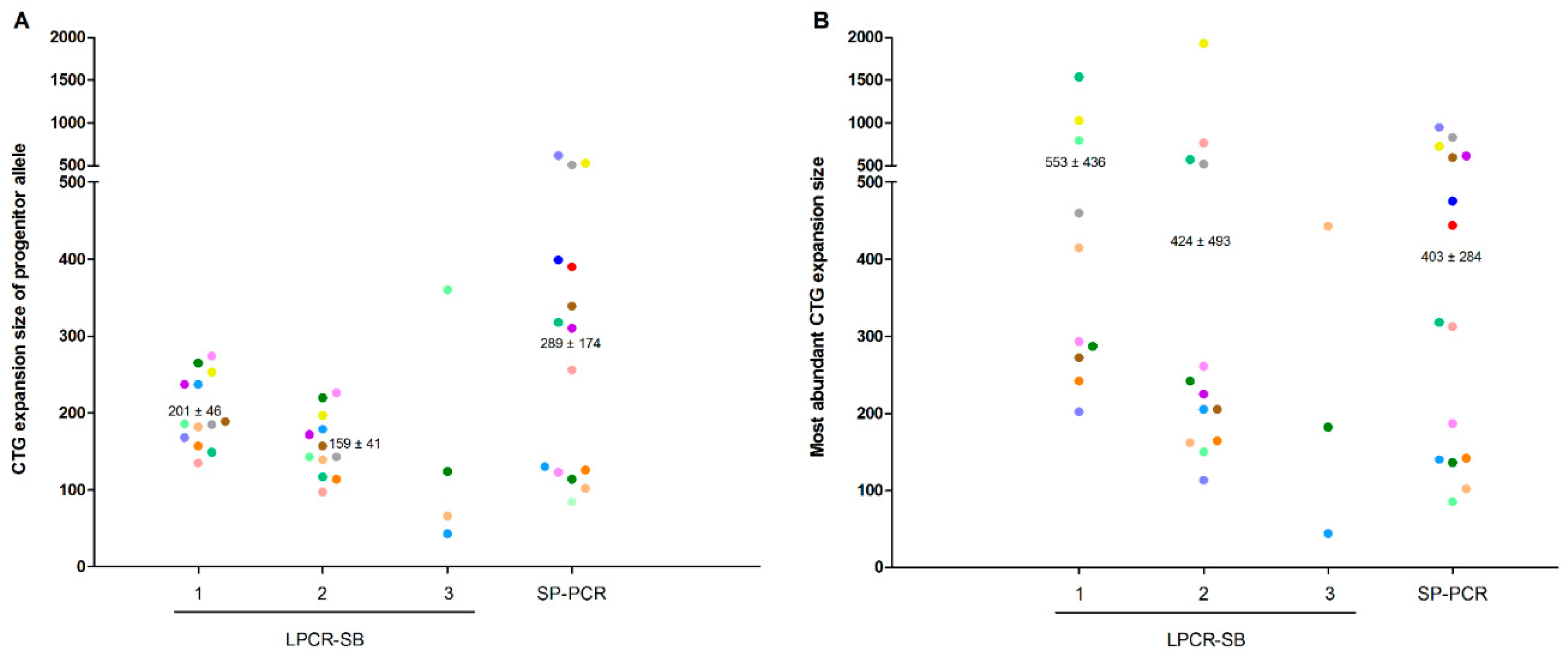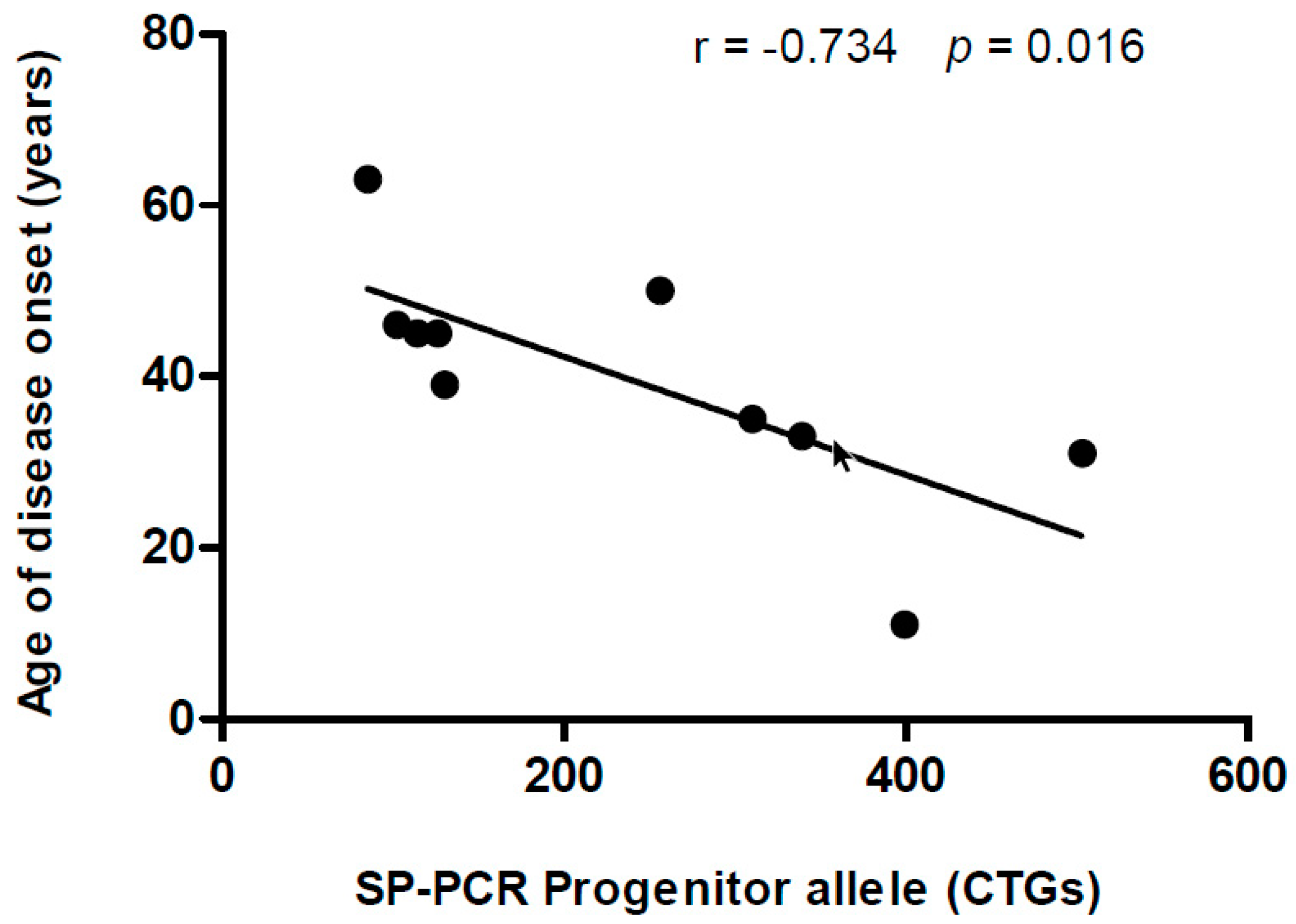The Need for Establishing a Universal CTG Sizing Method in Myotonic Dystrophy Type 1
Abstract
1. Introduction
2. Materials and Methods
2.1. DNA Extraction and Subjects
2.2. Heat Pulse Extension-PCR
2.3. Long PCR-Southern Blot
2.4. Small Pool-PCR
2.5. Statistical Analysis
3. Results
4. Discussion
5. Conclusions
Supplementary Materials
Author Contributions
Funding
Acknowledgments
Conflicts of Interest
References
- Brook, J.D.; McCurrach, M.E.; Harley, H.G.; Buckler, A.J.; Church, D.; Aburatani, H.; Hunter, K.; Stanton, V.P.; Thirion, J.P.; Hudson, T.; et al. Molecular basis of myotonic dystrophy: Expansion of a trinucleotide (CTG) repeat at the 3′ end of a transcript encoding a protein kinase family member. Cell 1992, 68, 799–808. [Google Scholar] [CrossRef]
- Turner, C.; Hilton-Jones, D. The myotonic dystrophies: Diagnosis and management. J. Neurol. Neurosurg. Psychiatry 2010, 81, 358–367. [Google Scholar] [CrossRef]
- Ashizawa, T.; Anvret, M.; Baiget, M.; Barcelo, J.M.; Brunner, H.; Cobo, A.M.; Dallapiccola, B.; Fenwick, R.G.; Grandell, U.; Harley, H.; et al. Characteristics of Intergenerational Contractions of the CTG Repeat in Myotonic Dystrophy. Am. J. Hum. Genet. 1994, 54, 414. [Google Scholar] [PubMed]
- Jakupciak, J.P.; Wells, R.D. Genetic Instabilities in (CTGCAG) Repeats Occur by Recombination* Downloaded from. J. Biol. Chem. 1999, 274, 23468–23479. Available online: http://www.jbc.org/ (accessed on 15 June 2020). [CrossRef] [PubMed]
- Monckton, D.G.; Wong, L.J.C.; Ashizawa, T.; Caskey, C.T. Somatic mosaicism, germline expansions, germline reversions and intergenerational reductions in myotonic dystrophy males: Small pool PCR analyses. Hum. Mol. Genet. 1995, 4, 1–8. [Google Scholar] [CrossRef] [PubMed]
- Salinas-Rios, V.; Belotserkovskii, B.P.; Hanawalt, P.C. DNA slip-outs cause RNA polymerase II arrest in vitro: Potential implications for genetic instability. Nucleic Acids Res. 2011, 39, 7444–7454. [Google Scholar] [CrossRef]
- Van Den Broek, W.J.A.A.; Nelen, M.R.; Wansink, D.G.; Coerwinkel, M.M.; Te Riele, H.; Groenen, P.J.T.A.; Wieringa, B. Somatic expansion behaviour of the (CTG) n repeat in myotonic dystrophy knock-in mice is differentially affected by Msh3 and Msh6 mismatch-repair proteins. Hum. Mol. Genet. 2002, 11, 191–198. [Google Scholar] [CrossRef]
- Ashizawa, T.; Dubel, J.R.; Harati, Y. Somatic instability of ctg repeat in myotonic dystrophy. Neurology 1993, 43, 2674–2678. [Google Scholar] [CrossRef]
- De Antonio, M.; Dogan, C.; Hamroun, D.; Mati, M.; Zerrouki, S.; Eymard, B.; Katsahian, S.; Bassez, G. French Myotonic Dystrophy Clinical Network. Unravelling the myotonic dystrophy type 1 clinical spectrum: A systematic registry-based study with implications for disease classification. Rev. Neurol. 2016, 172, 572–580. [Google Scholar] [CrossRef]
- Morales, F.; Couto, J.M.; Higham, C.F.; Hogg, G.; Cuenca, P.; Braida, C.; Wilson, R.H.; Adam, B.; Del Valle, G.; Brian, R.; et al. Somatic instability of the expanded CTG triplet repeat in myotonic dystrophy type 1 is a heritable quantitative trait and modifier of disease severity. Hum. Mol. Genet. 2012, 21, 3558–3567. [Google Scholar] [CrossRef]
- Leferink, M.; Wong, D.P.W.; Cai, S.; Yeo, M.; Ho, J.; Lian, M.; Kamsteeg, E.J.; Chong, S.S.; Haer-Wigman, L.; Guan, M. Robust and accurate detection and sizing of repeats within the DMPK gene using a novel TP-PCR test. Sci. Rep. 2019, 9. [Google Scholar] [CrossRef] [PubMed]
- Malbec, R.; Chami, B.; Aeschbach, L.; Ruiz Buendía, G.A.; Socol, M.; Joseph, P.; Leïchlé, T.; Trofimenko, E.; Bancaud, A.; Dion, V. µLAS: Sizing of expanded trinucleotide repeats with femtomolar sensitivity in less than 5 minutes. Sci. Rep. 2019, 9. [Google Scholar] [CrossRef] [PubMed]
- Orpana, A.K.; Ho, T.H.; Alagrund, K.; Ridanpää, M.; Aittomäki, K.; Stenman, J. Novel heat pulse extension-PCR-based method for detection of large CTG-repeat expansions in myotonic dystrophy type 1. J. Mol. Diagn. 2013, 15, 110–115. [Google Scholar] [CrossRef] [PubMed][Green Version]
- Savić, D.; Rakočvić-Stojanović, V.; Keckarević, D.; Čuljković, B.; Stojković, O.; Mladenoviić, J.; Todoroviić, S.; Apostolski, S.; Romac, S. 250 CTG repeats in DMPK is a threshold for correlation of expansion size and age at onset of juvenile-adult DM1. Hum. Mutat. 2002, 19, 131–139. [Google Scholar] [CrossRef] [PubMed]
- Siciliano, G.; Manca, M.; Gennarelli, M.; Angelini, C.; Rocchi, A.; Iudice, A.; Miorin, M.; Mostacciuolo, M. Epidemiology of myotonic dystrophy in Italy: Re-apprisal after genetic diagnosis. Clin. Genet. 2002, 59, 344–349. [Google Scholar] [CrossRef] [PubMed]
- Miller, S.A.; Dykes, D.D.; Polesky, H.F. A simple salting out procedure for extracting DNA from human nucleated cells. Nucleic Acids Res. 1988, 16, 1215. [Google Scholar] [CrossRef] [PubMed]
- Radvansky, J.; Ficek, A.; Kadasi, L. Upgrading molecular diagnostics of myotonic dystrophies: Multiplexing for simultaneous characterization of the DMPK and ZNF9 repeat motifs. Mol. Cell. Probes 2011, 25, 182–185. [Google Scholar] [CrossRef] [PubMed]
- Gomes-Pereira, M.; Bidichandani, S.I.; Monckton, D.G. Analysis of unstable triplet repeats using small-pool polymerase chain reaction. Methods Mol. Biol. 2004, 277, 61–76. [Google Scholar] [CrossRef]
- Musova, Z.; Mazanec, R.; Krepelova, A.; Ehler, E.; Vales, J.; Jaklova, R.; Prochazka, T.; Koukal, P.; Marikova, T.; Kraus, J.; et al. Highly unstable sequence interruptions of the CTG repeat in the myotonic dystrophy gene. Am. J. Med. Genet. A 2009, 149, 1365–1374. [Google Scholar] [CrossRef]
- Prior, T.W. Technical standards and guidelines for myotonic dystrophy type 1 testing. Genet. Med. 2009, 11, 552–555. [Google Scholar] [CrossRef]
- Cumming, S.A.; Jimenez-Moreno, C.; Okkersen, K.; Wenninger, S.; Daidj, F.; Hogarth, F.; Littleford, R.; Gorman, G.; Bassez, G.; Schoser, B.; et al. Genetic determinants of disease severity in the myotonic dystrophy type 1 OPTIMISTIC cohort. Neurology 2019, 93, e995–e1009. [Google Scholar] [CrossRef] [PubMed]



| Technique | bp of the Amplified Fragment (without CTG Expansion) | Primer Pair | Name | Sequence 5′—3′ | Reference |
|---|---|---|---|---|---|
| HPE-PCR | 324 | F | DMKf | GCCAGTTCACAACCGCTCCGAGCGTGGGTC | Orpana et al. [13] |
| R | DMKr | ACGCTCCCCAGAGCAGGGCGTCATGC | Orpana et al. [13] | ||
| LPCR1-SB | 112 | F | DM102 | GAACGGGGCTCGAAGGGTCCTTGT | Brook et al. [1] |
| R | DM101 | CTTCCCAGGCCTGCAGTTTGCCCATCCA | Brook et al. [1] | ||
| LPCR2-SB | 144 | F | MDY1D | GCTCGAAGGGTCCTTGTAGCCG | Siciliano et al. [15] |
| R | DM1REV | GTGCGTGGAGGATGGAAC | Radvansky et al. [17] | ||
| LPCR3-SB | 262 | F | MDY1D | GCTCGAAGGGTCCTTGTAGCCG | Siciliano et al. [15] |
| R | SOMY4R | CGGGTTTGGCAAAAGCAAATTTCCCGA | Musova et al. [19] | ||
| SP-PCR | 106 | F | DM-C | AACGGGGCTCGAAGGGTCCT | Monckton et al. [5]; Gomes-Pereira et al. [18] |
| R | DM-DR | CAGGCCTGCAGTTTGCCCATC | Monckton et al. [5]; Gomes-Pereira et al. [18] |
© 2020 by the authors. Licensee MDPI, Basel, Switzerland. This article is an open access article distributed under the terms and conditions of the Creative Commons Attribution (CC BY) license (http://creativecommons.org/licenses/by/4.0/).
Share and Cite
Ballester-Lopez, A.; Linares-Pardo, I.; Koehorst, E.; Núñez-Manchón, J.; Pintos-Morell, G.; Coll-Cantí, J.; Almendrote, M.; Lucente, G.; Arbex, A.; Magaña, J.J.; et al. The Need for Establishing a Universal CTG Sizing Method in Myotonic Dystrophy Type 1. Genes 2020, 11, 757. https://doi.org/10.3390/genes11070757
Ballester-Lopez A, Linares-Pardo I, Koehorst E, Núñez-Manchón J, Pintos-Morell G, Coll-Cantí J, Almendrote M, Lucente G, Arbex A, Magaña JJ, et al. The Need for Establishing a Universal CTG Sizing Method in Myotonic Dystrophy Type 1. Genes. 2020; 11(7):757. https://doi.org/10.3390/genes11070757
Chicago/Turabian StyleBallester-Lopez, Alfonsina, Ian Linares-Pardo, Emma Koehorst, Judit Núñez-Manchón, Guillem Pintos-Morell, Jaume Coll-Cantí, Miriam Almendrote, Giuseppe Lucente, Andrea Arbex, Jonathan J. Magaña, and et al. 2020. "The Need for Establishing a Universal CTG Sizing Method in Myotonic Dystrophy Type 1" Genes 11, no. 7: 757. https://doi.org/10.3390/genes11070757
APA StyleBallester-Lopez, A., Linares-Pardo, I., Koehorst, E., Núñez-Manchón, J., Pintos-Morell, G., Coll-Cantí, J., Almendrote, M., Lucente, G., Arbex, A., Magaña, J. J., Murillo-Melo, N. M., Lucia, A., Monckton, D. G., Cumming, S. A., Ramos-Fransi, A., Martínez-Piñeiro, A., & Nogales-Gadea, G. (2020). The Need for Establishing a Universal CTG Sizing Method in Myotonic Dystrophy Type 1. Genes, 11(7), 757. https://doi.org/10.3390/genes11070757







